Strategic HRM: How IPRP Impacts Employee Motivation and Performance
VerifiedAdded on 2022/12/14
|8
|2229
|77
Essay
AI Summary
This essay critically evaluates the extent to which individual performance-related pay (IPRP) can stimulate higher levels of performance from employees, using Tesco as an example. It explores how IPRP motivates employees by linking salary to performance, fostering retention, and attracting talent. The essay also considers circumstances where IPRP may not be effective, such as when reward systems are poorly designed, economic conditions are adverse, or individual contributions within group settings are difficult to assess. The importance of fair compensation, effective reward management, and addressing salary gaps during inflation are highlighted. The essay concludes that a well-designed IPRP system, aligned with employee needs and organizational goals, is crucial for enhancing motivation and performance.
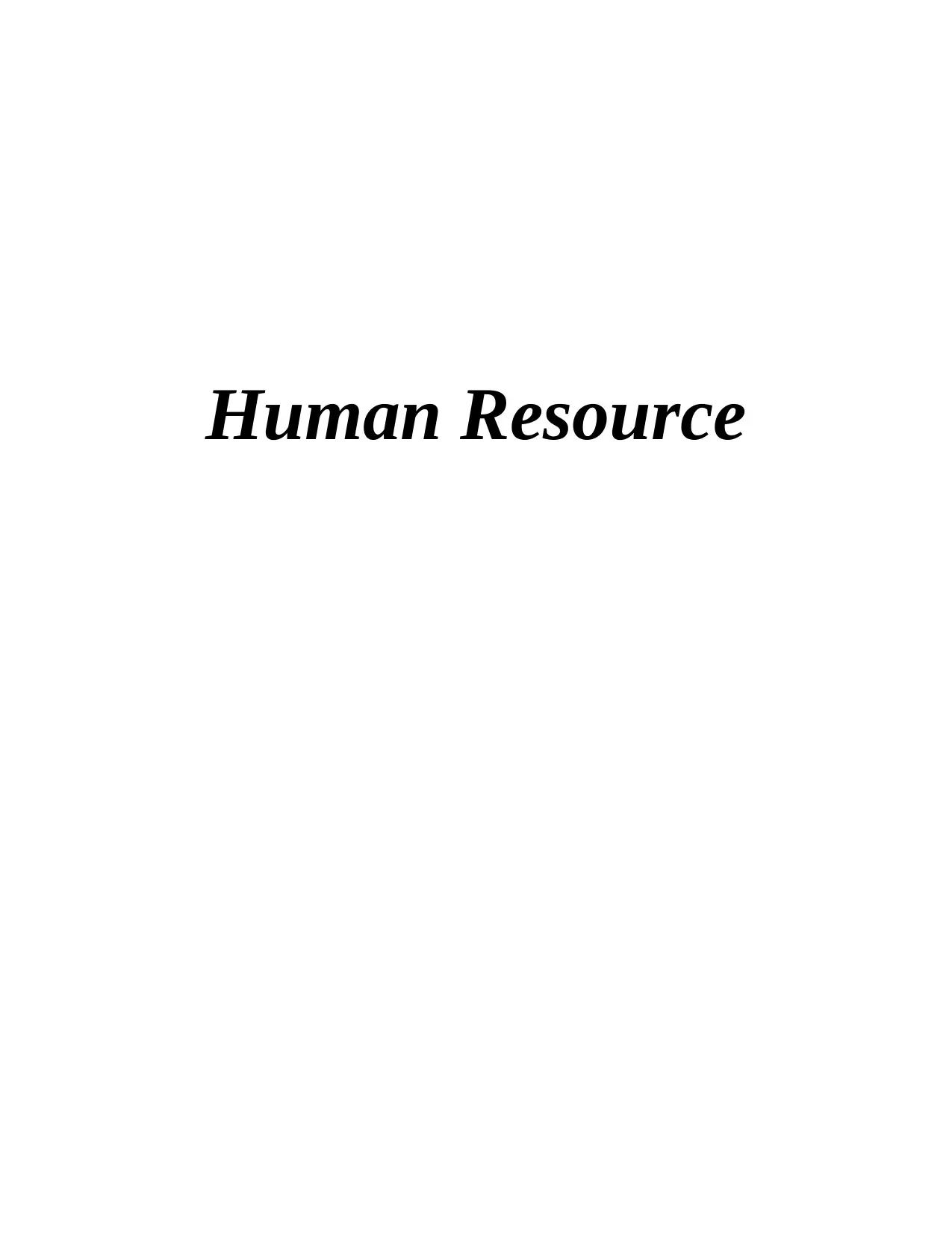
Human Resource
Paraphrase This Document
Need a fresh take? Get an instant paraphrase of this document with our AI Paraphraser
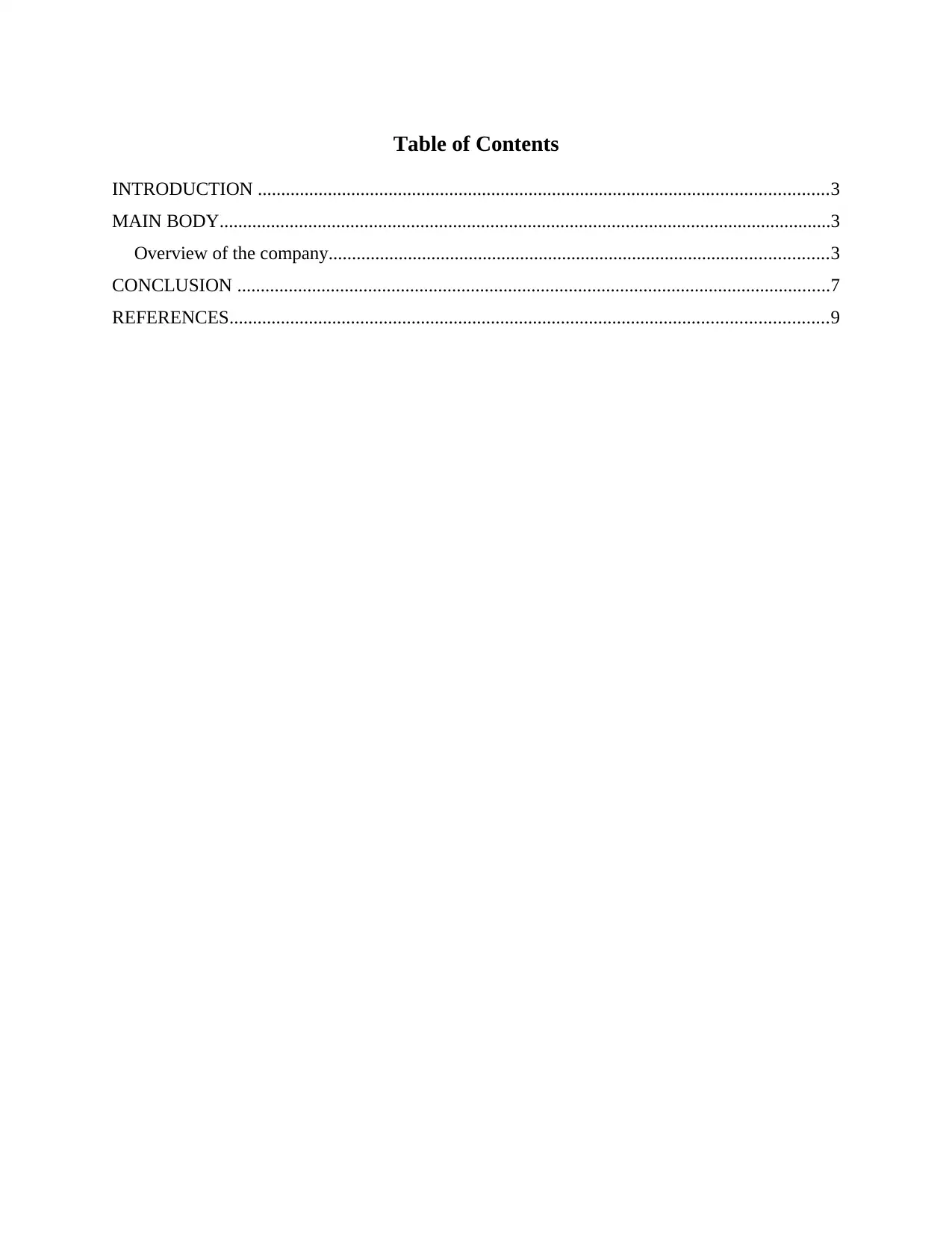
Table of Contents
INTRODUCTION ..........................................................................................................................3
MAIN BODY...................................................................................................................................3
Overview of the company...........................................................................................................3
CONCLUSION ...............................................................................................................................7
REFERENCES................................................................................................................................9
INTRODUCTION ..........................................................................................................................3
MAIN BODY...................................................................................................................................3
Overview of the company...........................................................................................................3
CONCLUSION ...............................................................................................................................7
REFERENCES................................................................................................................................9
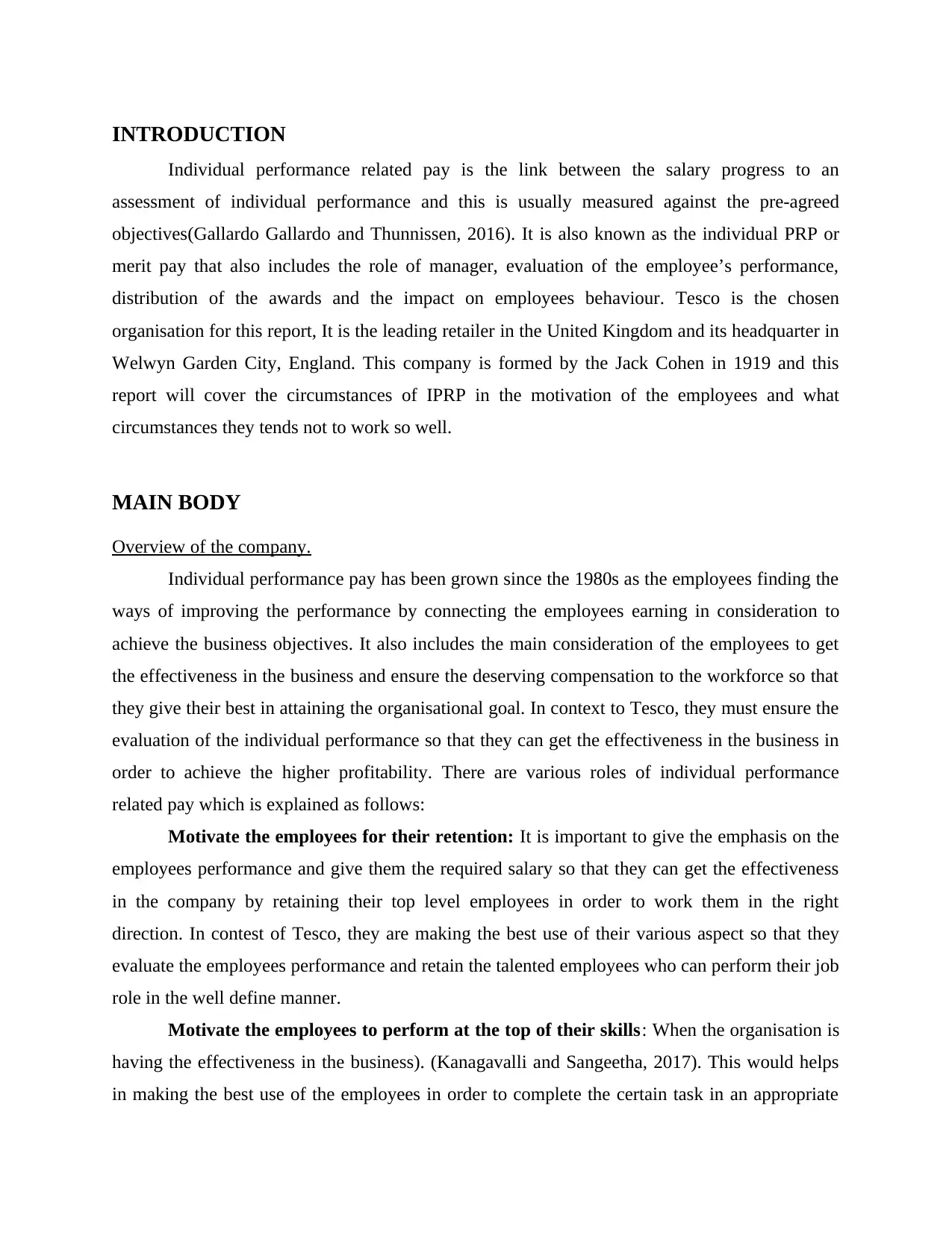
INTRODUCTION
Individual performance related pay is the link between the salary progress to an
assessment of individual performance and this is usually measured against the pre-agreed
objectives(Gallardo Gallardo and Thunnissen, 2016). It is also known as the individual PRP or
merit pay that also includes the role of manager, evaluation of the employee’s performance,
distribution of the awards and the impact on employees behaviour. Tesco is the chosen
organisation for this report, It is the leading retailer in the United Kingdom and its headquarter in
Welwyn Garden City, England. This company is formed by the Jack Cohen in 1919 and this
report will cover the circumstances of IPRP in the motivation of the employees and what
circumstances they tends not to work so well.
MAIN BODY
Overview of the company.
Individual performance pay has been grown since the 1980s as the employees finding the
ways of improving the performance by connecting the employees earning in consideration to
achieve the business objectives. It also includes the main consideration of the employees to get
the effectiveness in the business and ensure the deserving compensation to the workforce so that
they give their best in attaining the organisational goal. In context to Tesco, they must ensure the
evaluation of the individual performance so that they can get the effectiveness in the business in
order to achieve the higher profitability. There are various roles of individual performance
related pay which is explained as follows:
Motivate the employees for their retention: It is important to give the emphasis on the
employees performance and give them the required salary so that they can get the effectiveness
in the company by retaining their top level employees in order to work them in the right
direction. In contest of Tesco, they are making the best use of their various aspect so that they
evaluate the employees performance and retain the talented employees who can perform their job
role in the well define manner.
Motivate the employees to perform at the top of their skills: When the organisation is
having the effectiveness in the business). (Kanagavalli and Sangeetha, 2017). This would helps
in making the best use of the employees in order to complete the certain task in an appropriate
Individual performance related pay is the link between the salary progress to an
assessment of individual performance and this is usually measured against the pre-agreed
objectives(Gallardo Gallardo and Thunnissen, 2016). It is also known as the individual PRP or
merit pay that also includes the role of manager, evaluation of the employee’s performance,
distribution of the awards and the impact on employees behaviour. Tesco is the chosen
organisation for this report, It is the leading retailer in the United Kingdom and its headquarter in
Welwyn Garden City, England. This company is formed by the Jack Cohen in 1919 and this
report will cover the circumstances of IPRP in the motivation of the employees and what
circumstances they tends not to work so well.
MAIN BODY
Overview of the company.
Individual performance pay has been grown since the 1980s as the employees finding the
ways of improving the performance by connecting the employees earning in consideration to
achieve the business objectives. It also includes the main consideration of the employees to get
the effectiveness in the business and ensure the deserving compensation to the workforce so that
they give their best in attaining the organisational goal. In context to Tesco, they must ensure the
evaluation of the individual performance so that they can get the effectiveness in the business in
order to achieve the higher profitability. There are various roles of individual performance
related pay which is explained as follows:
Motivate the employees for their retention: It is important to give the emphasis on the
employees performance and give them the required salary so that they can get the effectiveness
in the company by retaining their top level employees in order to work them in the right
direction. In contest of Tesco, they are making the best use of their various aspect so that they
evaluate the employees performance and retain the talented employees who can perform their job
role in the well define manner.
Motivate the employees to perform at the top of their skills: When the organisation is
having the effectiveness in the business). (Kanagavalli and Sangeetha, 2017). This would helps
in making the best use of the employees in order to complete the certain task in an appropriate
⊘ This is a preview!⊘
Do you want full access?
Subscribe today to unlock all pages.

Trusted by 1+ million students worldwide
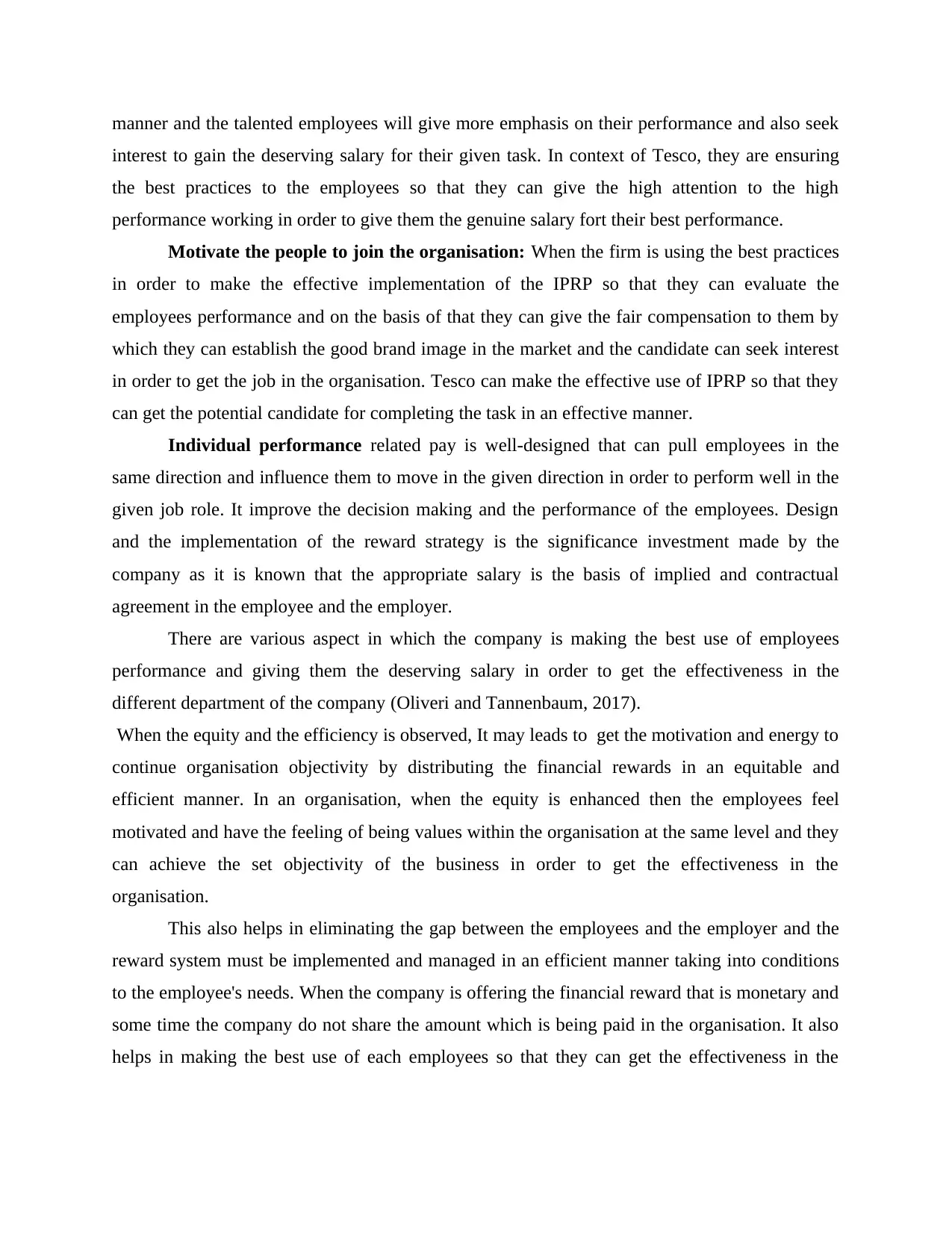
manner and the talented employees will give more emphasis on their performance and also seek
interest to gain the deserving salary for their given task. In context of Tesco, they are ensuring
the best practices to the employees so that they can give the high attention to the high
performance working in order to give them the genuine salary fort their best performance.
Motivate the people to join the organisation: When the firm is using the best practices
in order to make the effective implementation of the IPRP so that they can evaluate the
employees performance and on the basis of that they can give the fair compensation to them by
which they can establish the good brand image in the market and the candidate can seek interest
in order to get the job in the organisation. Tesco can make the effective use of IPRP so that they
can get the potential candidate for completing the task in an effective manner.
Individual performance related pay is well-designed that can pull employees in the
same direction and influence them to move in the given direction in order to perform well in the
given job role. It improve the decision making and the performance of the employees. Design
and the implementation of the reward strategy is the significance investment made by the
company as it is known that the appropriate salary is the basis of implied and contractual
agreement in the employee and the employer.
There are various aspect in which the company is making the best use of employees
performance and giving them the deserving salary in order to get the effectiveness in the
different department of the company (Oliveri and Tannenbaum, 2017).
When the equity and the efficiency is observed, It may leads to get the motivation and energy to
continue organisation objectivity by distributing the financial rewards in an equitable and
efficient manner. In an organisation, when the equity is enhanced then the employees feel
motivated and have the feeling of being values within the organisation at the same level and they
can achieve the set objectivity of the business in order to get the effectiveness in the
organisation.
This also helps in eliminating the gap between the employees and the employer and the
reward system must be implemented and managed in an efficient manner taking into conditions
to the employee's needs. When the company is offering the financial reward that is monetary and
some time the company do not share the amount which is being paid in the organisation. It also
helps in making the best use of each employees so that they can get the effectiveness in the
interest to gain the deserving salary for their given task. In context of Tesco, they are ensuring
the best practices to the employees so that they can give the high attention to the high
performance working in order to give them the genuine salary fort their best performance.
Motivate the people to join the organisation: When the firm is using the best practices
in order to make the effective implementation of the IPRP so that they can evaluate the
employees performance and on the basis of that they can give the fair compensation to them by
which they can establish the good brand image in the market and the candidate can seek interest
in order to get the job in the organisation. Tesco can make the effective use of IPRP so that they
can get the potential candidate for completing the task in an effective manner.
Individual performance related pay is well-designed that can pull employees in the
same direction and influence them to move in the given direction in order to perform well in the
given job role. It improve the decision making and the performance of the employees. Design
and the implementation of the reward strategy is the significance investment made by the
company as it is known that the appropriate salary is the basis of implied and contractual
agreement in the employee and the employer.
There are various aspect in which the company is making the best use of employees
performance and giving them the deserving salary in order to get the effectiveness in the
different department of the company (Oliveri and Tannenbaum, 2017).
When the equity and the efficiency is observed, It may leads to get the motivation and energy to
continue organisation objectivity by distributing the financial rewards in an equitable and
efficient manner. In an organisation, when the equity is enhanced then the employees feel
motivated and have the feeling of being values within the organisation at the same level and they
can achieve the set objectivity of the business in order to get the effectiveness in the
organisation.
This also helps in eliminating the gap between the employees and the employer and the
reward system must be implemented and managed in an efficient manner taking into conditions
to the employee's needs. When the company is offering the financial reward that is monetary and
some time the company do not share the amount which is being paid in the organisation. It also
helps in making the best use of each employees so that they can get the effectiveness in the
Paraphrase This Document
Need a fresh take? Get an instant paraphrase of this document with our AI Paraphraser
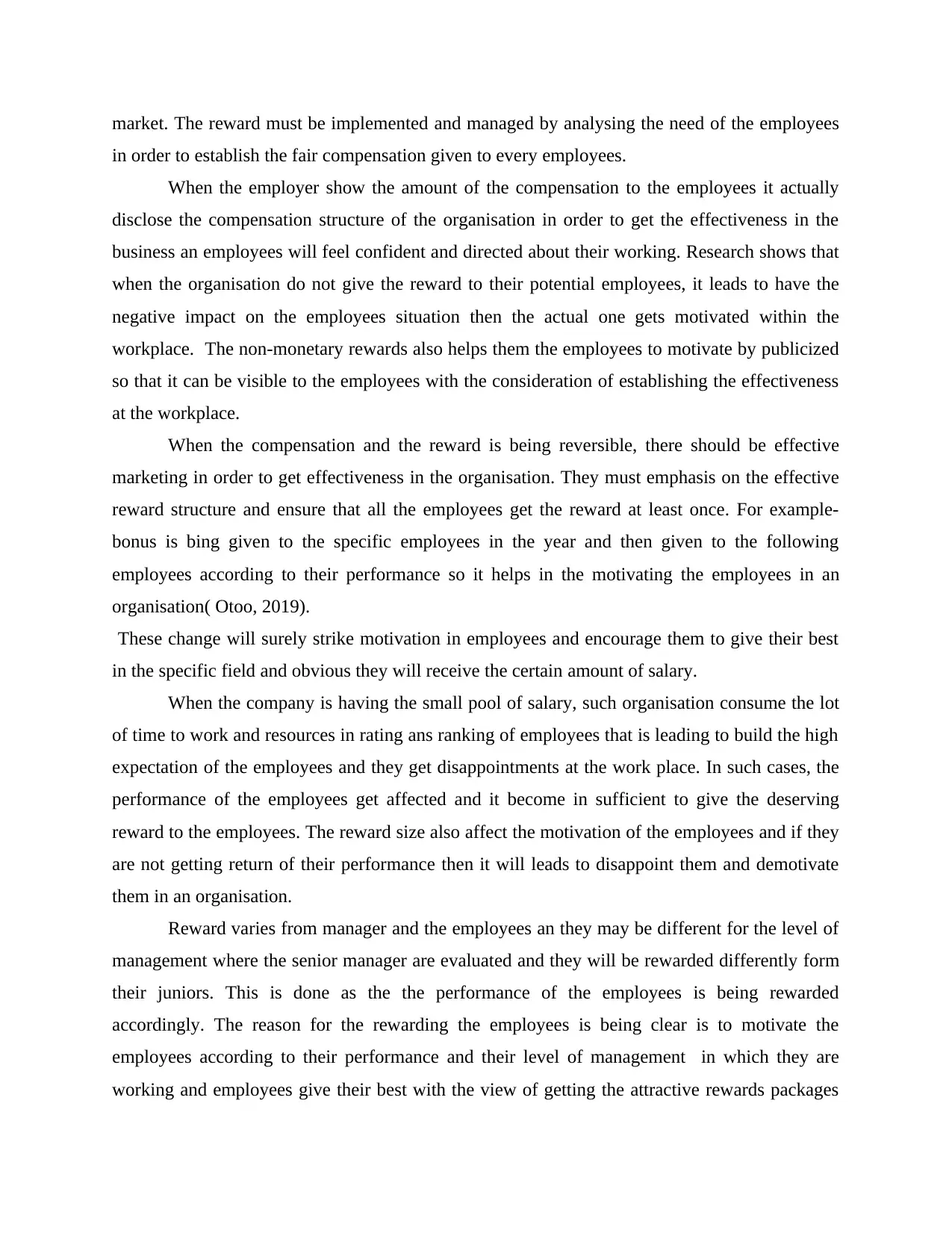
market. The reward must be implemented and managed by analysing the need of the employees
in order to establish the fair compensation given to every employees.
When the employer show the amount of the compensation to the employees it actually
disclose the compensation structure of the organisation in order to get the effectiveness in the
business an employees will feel confident and directed about their working. Research shows that
when the organisation do not give the reward to their potential employees, it leads to have the
negative impact on the employees situation then the actual one gets motivated within the
workplace. The non-monetary rewards also helps them the employees to motivate by publicized
so that it can be visible to the employees with the consideration of establishing the effectiveness
at the workplace.
When the compensation and the reward is being reversible, there should be effective
marketing in order to get effectiveness in the organisation. They must emphasis on the effective
reward structure and ensure that all the employees get the reward at least once. For example-
bonus is bing given to the specific employees in the year and then given to the following
employees according to their performance so it helps in the motivating the employees in an
organisation( Otoo, 2019).
These change will surely strike motivation in employees and encourage them to give their best
in the specific field and obvious they will receive the certain amount of salary.
When the company is having the small pool of salary, such organisation consume the lot
of time to work and resources in rating ans ranking of employees that is leading to build the high
expectation of the employees and they get disappointments at the work place. In such cases, the
performance of the employees get affected and it become in sufficient to give the deserving
reward to the employees. The reward size also affect the motivation of the employees and if they
are not getting return of their performance then it will leads to disappoint them and demotivate
them in an organisation.
Reward varies from manager and the employees an they may be different for the level of
management where the senior manager are evaluated and they will be rewarded differently form
their juniors. This is done as the the performance of the employees is being rewarded
accordingly. The reason for the rewarding the employees is being clear is to motivate the
employees according to their performance and their level of management in which they are
working and employees give their best with the view of getting the attractive rewards packages
in order to establish the fair compensation given to every employees.
When the employer show the amount of the compensation to the employees it actually
disclose the compensation structure of the organisation in order to get the effectiveness in the
business an employees will feel confident and directed about their working. Research shows that
when the organisation do not give the reward to their potential employees, it leads to have the
negative impact on the employees situation then the actual one gets motivated within the
workplace. The non-monetary rewards also helps them the employees to motivate by publicized
so that it can be visible to the employees with the consideration of establishing the effectiveness
at the workplace.
When the compensation and the reward is being reversible, there should be effective
marketing in order to get effectiveness in the organisation. They must emphasis on the effective
reward structure and ensure that all the employees get the reward at least once. For example-
bonus is bing given to the specific employees in the year and then given to the following
employees according to their performance so it helps in the motivating the employees in an
organisation( Otoo, 2019).
These change will surely strike motivation in employees and encourage them to give their best
in the specific field and obvious they will receive the certain amount of salary.
When the company is having the small pool of salary, such organisation consume the lot
of time to work and resources in rating ans ranking of employees that is leading to build the high
expectation of the employees and they get disappointments at the work place. In such cases, the
performance of the employees get affected and it become in sufficient to give the deserving
reward to the employees. The reward size also affect the motivation of the employees and if they
are not getting return of their performance then it will leads to disappoint them and demotivate
them in an organisation.
Reward varies from manager and the employees an they may be different for the level of
management where the senior manager are evaluated and they will be rewarded differently form
their juniors. This is done as the the performance of the employees is being rewarded
accordingly. The reason for the rewarding the employees is being clear is to motivate the
employees according to their performance and their level of management in which they are
working and employees give their best with the view of getting the attractive rewards packages
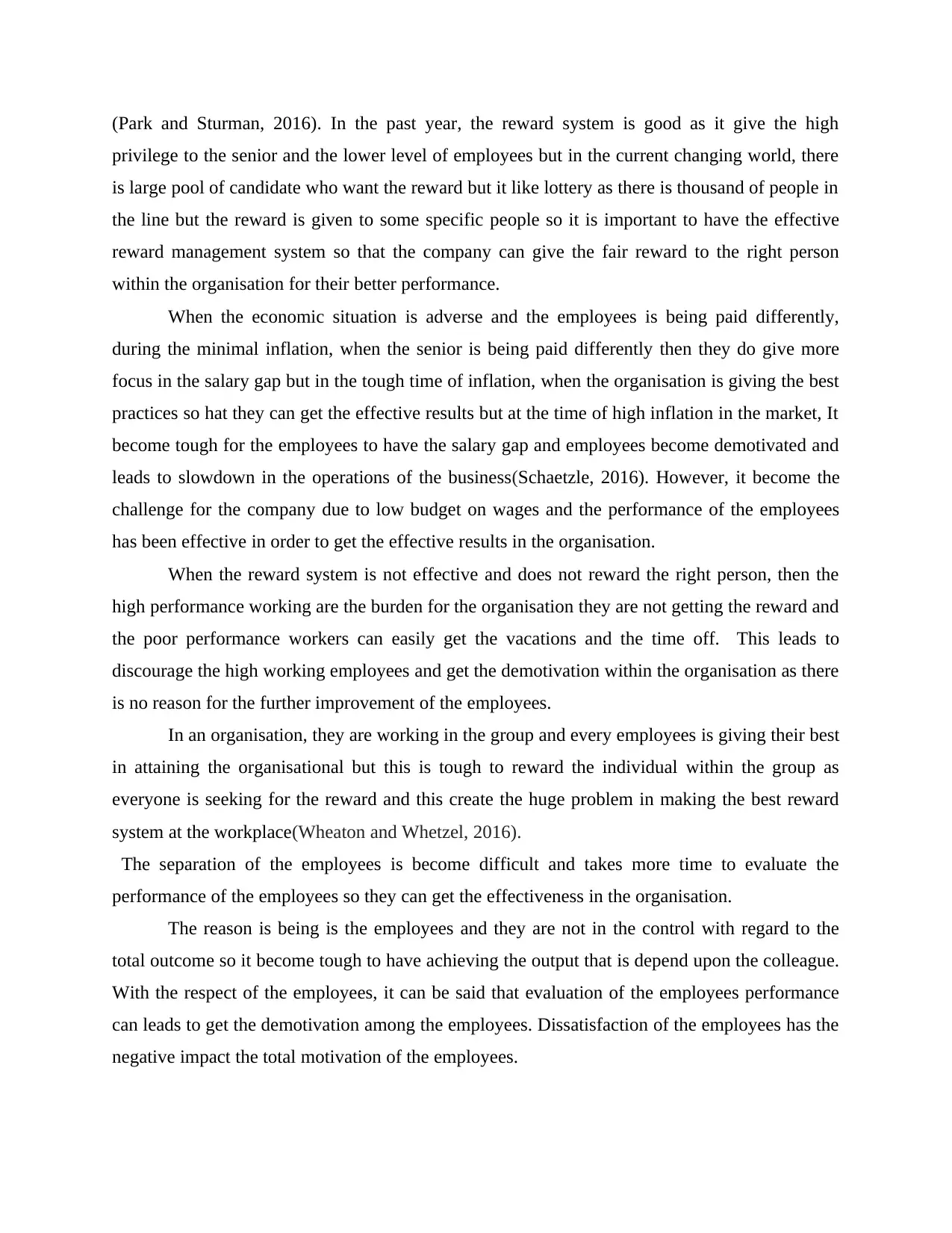
(Park and Sturman, 2016). In the past year, the reward system is good as it give the high
privilege to the senior and the lower level of employees but in the current changing world, there
is large pool of candidate who want the reward but it like lottery as there is thousand of people in
the line but the reward is given to some specific people so it is important to have the effective
reward management system so that the company can give the fair reward to the right person
within the organisation for their better performance.
When the economic situation is adverse and the employees is being paid differently,
during the minimal inflation, when the senior is being paid differently then they do give more
focus in the salary gap but in the tough time of inflation, when the organisation is giving the best
practices so hat they can get the effective results but at the time of high inflation in the market, It
become tough for the employees to have the salary gap and employees become demotivated and
leads to slowdown in the operations of the business(Schaetzle, 2016). However, it become the
challenge for the company due to low budget on wages and the performance of the employees
has been effective in order to get the effective results in the organisation.
When the reward system is not effective and does not reward the right person, then the
high performance working are the burden for the organisation they are not getting the reward and
the poor performance workers can easily get the vacations and the time off. This leads to
discourage the high working employees and get the demotivation within the organisation as there
is no reason for the further improvement of the employees.
In an organisation, they are working in the group and every employees is giving their best
in attaining the organisational but this is tough to reward the individual within the group as
everyone is seeking for the reward and this create the huge problem in making the best reward
system at the workplace(Wheaton and Whetzel, 2016).
The separation of the employees is become difficult and takes more time to evaluate the
performance of the employees so they can get the effectiveness in the organisation.
The reason is being is the employees and they are not in the control with regard to the
total outcome so it become tough to have achieving the output that is depend upon the colleague.
With the respect of the employees, it can be said that evaluation of the employees performance
can leads to get the demotivation among the employees. Dissatisfaction of the employees has the
negative impact the total motivation of the employees.
privilege to the senior and the lower level of employees but in the current changing world, there
is large pool of candidate who want the reward but it like lottery as there is thousand of people in
the line but the reward is given to some specific people so it is important to have the effective
reward management system so that the company can give the fair reward to the right person
within the organisation for their better performance.
When the economic situation is adverse and the employees is being paid differently,
during the minimal inflation, when the senior is being paid differently then they do give more
focus in the salary gap but in the tough time of inflation, when the organisation is giving the best
practices so hat they can get the effective results but at the time of high inflation in the market, It
become tough for the employees to have the salary gap and employees become demotivated and
leads to slowdown in the operations of the business(Schaetzle, 2016). However, it become the
challenge for the company due to low budget on wages and the performance of the employees
has been effective in order to get the effective results in the organisation.
When the reward system is not effective and does not reward the right person, then the
high performance working are the burden for the organisation they are not getting the reward and
the poor performance workers can easily get the vacations and the time off. This leads to
discourage the high working employees and get the demotivation within the organisation as there
is no reason for the further improvement of the employees.
In an organisation, they are working in the group and every employees is giving their best
in attaining the organisational but this is tough to reward the individual within the group as
everyone is seeking for the reward and this create the huge problem in making the best reward
system at the workplace(Wheaton and Whetzel, 2016).
The separation of the employees is become difficult and takes more time to evaluate the
performance of the employees so they can get the effectiveness in the organisation.
The reason is being is the employees and they are not in the control with regard to the
total outcome so it become tough to have achieving the output that is depend upon the colleague.
With the respect of the employees, it can be said that evaluation of the employees performance
can leads to get the demotivation among the employees. Dissatisfaction of the employees has the
negative impact the total motivation of the employees.
⊘ This is a preview!⊘
Do you want full access?
Subscribe today to unlock all pages.

Trusted by 1+ million students worldwide
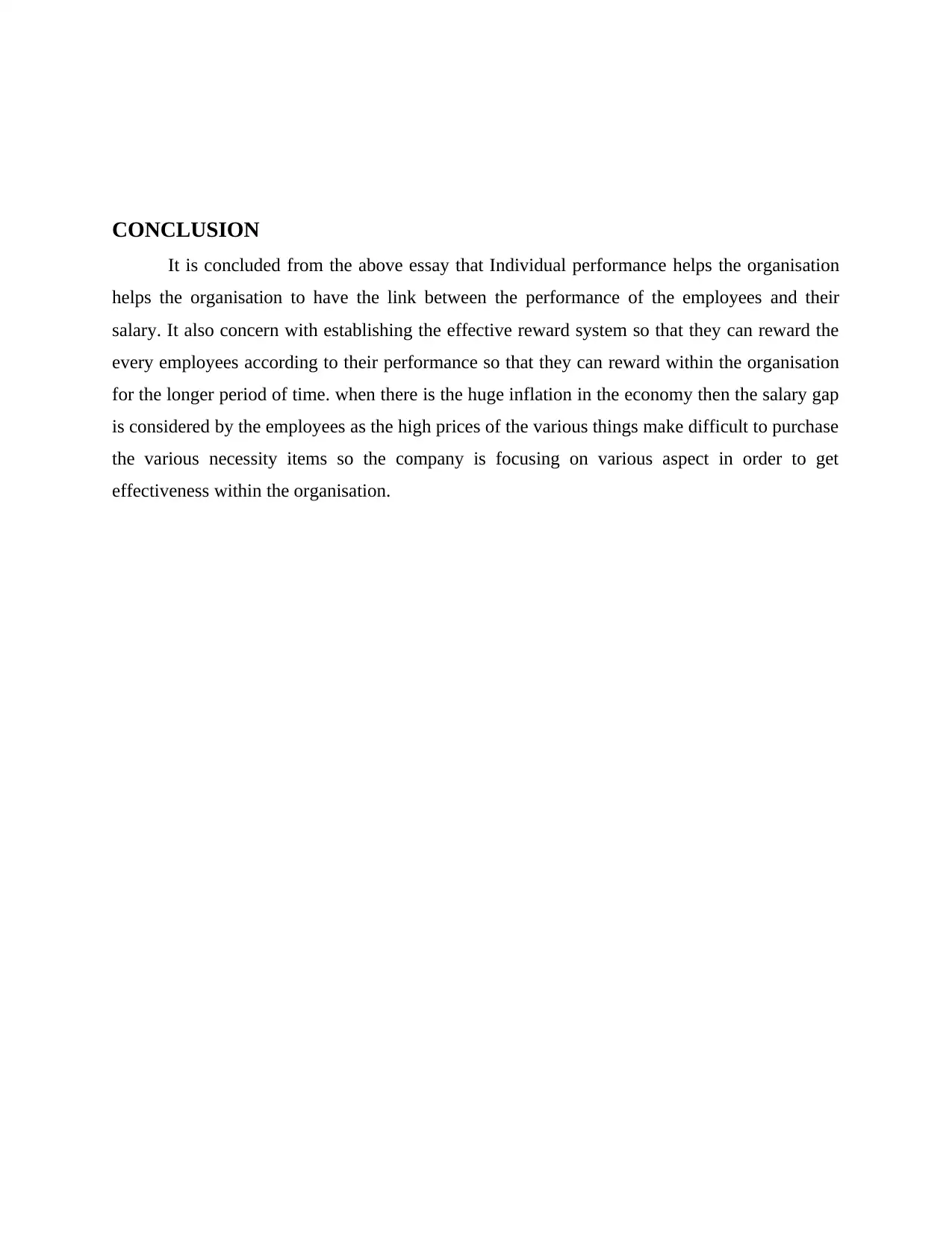
CONCLUSION
It is concluded from the above essay that Individual performance helps the organisation
helps the organisation to have the link between the performance of the employees and their
salary. It also concern with establishing the effective reward system so that they can reward the
every employees according to their performance so that they can reward within the organisation
for the longer period of time. when there is the huge inflation in the economy then the salary gap
is considered by the employees as the high prices of the various things make difficult to purchase
the various necessity items so the company is focusing on various aspect in order to get
effectiveness within the organisation.
It is concluded from the above essay that Individual performance helps the organisation
helps the organisation to have the link between the performance of the employees and their
salary. It also concern with establishing the effective reward system so that they can reward the
every employees according to their performance so that they can reward within the organisation
for the longer period of time. when there is the huge inflation in the economy then the salary gap
is considered by the employees as the high prices of the various things make difficult to purchase
the various necessity items so the company is focusing on various aspect in order to get
effectiveness within the organisation.
Paraphrase This Document
Need a fresh take? Get an instant paraphrase of this document with our AI Paraphraser
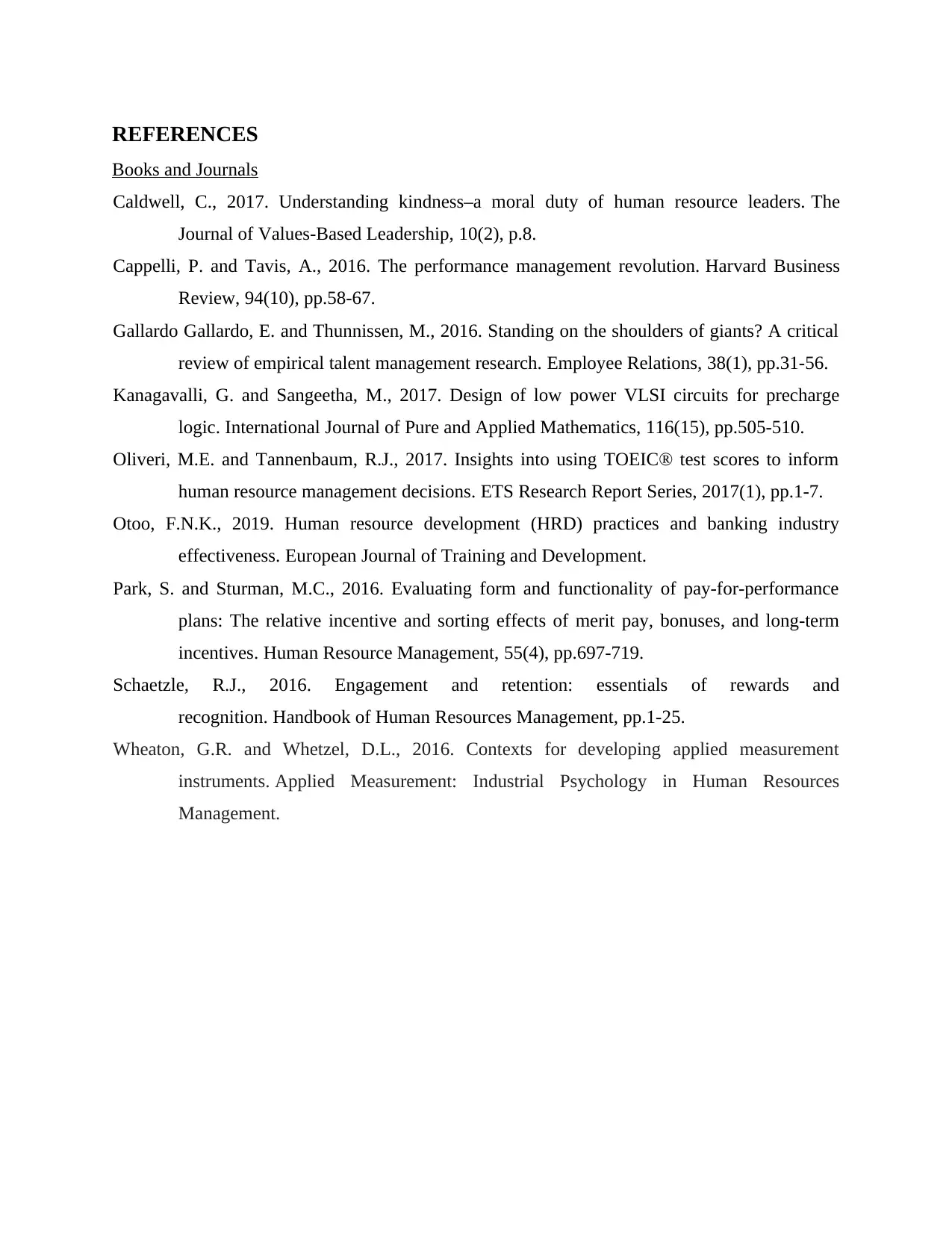
REFERENCES
Books and Journals
Caldwell, C., 2017. Understanding kindness–a moral duty of human resource leaders. The
Journal of Values-Based Leadership, 10(2), p.8.
Cappelli, P. and Tavis, A., 2016. The performance management revolution. Harvard Business
Review, 94(10), pp.58-67.
Gallardo Gallardo, E. and Thunnissen, M., 2016. Standing on the shoulders of giants? A critical
review of empirical talent management research. Employee Relations, 38(1), pp.31-56.
Kanagavalli, G. and Sangeetha, M., 2017. Design of low power VLSI circuits for precharge
logic. International Journal of Pure and Applied Mathematics, 116(15), pp.505-510.
Oliveri, M.E. and Tannenbaum, R.J., 2017. Insights into using TOEIC® test scores to inform
human resource management decisions. ETS Research Report Series, 2017(1), pp.1-7.
Otoo, F.N.K., 2019. Human resource development (HRD) practices and banking industry
effectiveness. European Journal of Training and Development.
Park, S. and Sturman, M.C., 2016. Evaluating form and functionality of pay‐for‐performance
plans: The relative incentive and sorting effects of merit pay, bonuses, and long‐term
incentives. Human Resource Management, 55(4), pp.697-719.
Schaetzle, R.J., 2016. Engagement and retention: essentials of rewards and
recognition. Handbook of Human Resources Management, pp.1-25.
Wheaton, G.R. and Whetzel, D.L., 2016. Contexts for developing applied measurement
instruments. Applied Measurement: Industrial Psychology in Human Resources
Management.
Books and Journals
Caldwell, C., 2017. Understanding kindness–a moral duty of human resource leaders. The
Journal of Values-Based Leadership, 10(2), p.8.
Cappelli, P. and Tavis, A., 2016. The performance management revolution. Harvard Business
Review, 94(10), pp.58-67.
Gallardo Gallardo, E. and Thunnissen, M., 2016. Standing on the shoulders of giants? A critical
review of empirical talent management research. Employee Relations, 38(1), pp.31-56.
Kanagavalli, G. and Sangeetha, M., 2017. Design of low power VLSI circuits for precharge
logic. International Journal of Pure and Applied Mathematics, 116(15), pp.505-510.
Oliveri, M.E. and Tannenbaum, R.J., 2017. Insights into using TOEIC® test scores to inform
human resource management decisions. ETS Research Report Series, 2017(1), pp.1-7.
Otoo, F.N.K., 2019. Human resource development (HRD) practices and banking industry
effectiveness. European Journal of Training and Development.
Park, S. and Sturman, M.C., 2016. Evaluating form and functionality of pay‐for‐performance
plans: The relative incentive and sorting effects of merit pay, bonuses, and long‐term
incentives. Human Resource Management, 55(4), pp.697-719.
Schaetzle, R.J., 2016. Engagement and retention: essentials of rewards and
recognition. Handbook of Human Resources Management, pp.1-25.
Wheaton, G.R. and Whetzel, D.L., 2016. Contexts for developing applied measurement
instruments. Applied Measurement: Industrial Psychology in Human Resources
Management.
1 out of 8
Related Documents
Your All-in-One AI-Powered Toolkit for Academic Success.
+13062052269
info@desklib.com
Available 24*7 on WhatsApp / Email
![[object Object]](/_next/static/media/star-bottom.7253800d.svg)
Unlock your academic potential
Copyright © 2020–2025 A2Z Services. All Rights Reserved. Developed and managed by ZUCOL.





